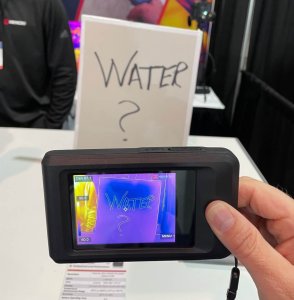Over the years, even though the insulators didn’t build the roof, hang the siding, design the mechanical, or put plumbing in an outside wall, I’ve been surprised how often insulators are called to be part of the “fix”. Even worse, in many cases they are being asked to participate in this “pro bono” because someone else tried to attribute part of the cause to them.
Does spray foam insulation stop water leaks? It can, though it’s not its primary purpose. Have I ever ever seen properly installed spray foam cause moisture or water intrusion into a building? No. My inspiration for this article was to help insulation contractors clear their name and help building owners find the true source of their moisture issues after I read a blog from Edward Pon. The blog, How to Perform a Leak Investigation did a great job explaining how to find water leaks. You always start a leak investigation at the base or the lowest point where water was found inside.
I found this tactic wise, especially after seeing walls where landscaping sprinkler heads were turned the wrong way causing them to permeate the brick daily and flood the wall. After soaking in the moisture, the building materials allowed the water to travel further up the wall. There is also something known as capillary action. Capillary movement of water can pull water up between surfaces. Here’s more on this from Building Science Corp.
With the aforementioned in mind, just imagine the fun you could have chasing down leaks in a multi-floor facility by starting at the top. A friend was working on a 30-story building in Miami that had water leaking into the bank on the first floor. Everyone in the building thought it was a roof leak because it only showed up when it rained. The owners tried to fix the roof several times and called the building performance/insulation installer after much frustration.
Upon investigation, the problem was nowhere near the roof. It was on the second floor. Giant masses of ice had formed on the concrete deck underneath three restaurant freezers. Every time it rained, the humidity levels in the building got really high and the ice formations became giant condensing surfaces, causing it to rain on the ceiling below.
Finding leaks can be challenging, so if you get one of these calls and decide to help, I encourage you to read Edward’s blog because it may come in handy when you need it most.

Another great tool you don’t want to forget is infrared. Check out the picture I took of an infrared camera looking at a piece of drywall with only a damp Kleenex stuck to the back of it. Infrared cameras are a valuable water leak detection device. Allowing you to find the source of moisture and show a building owner where they have a problem. They are also much smaller today and the definition just gets better and better. I would also point out that prices have come down dramatically, making them very affordable. If you’re interested in getting one for your business, check out our Infrared Camera Comparison video to help you pick the right one.
Like anything else, you never know where your next challenge may come from. Our goal at IDI is to partner with you by providing the best products and resources even when we’re sharing sources outside our own.
If you have challenges or building science questions dealing with any of the products we carry, reach out to your local branch or contact any of us at IDI. We will be happy to do everything we can to help, as we strive to earn your business every day.
Written by IDI’s Business Development Manager, Ken Allison.